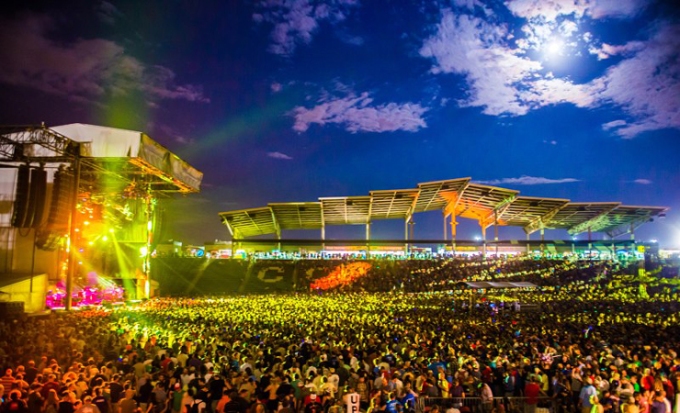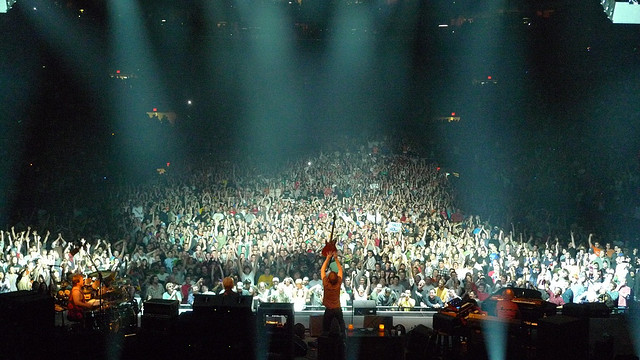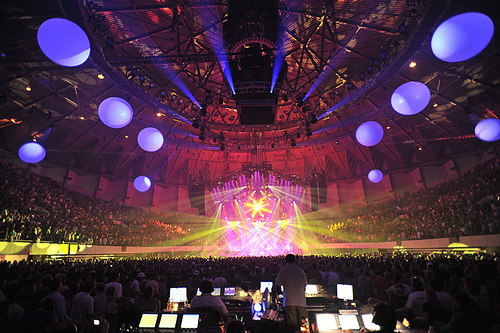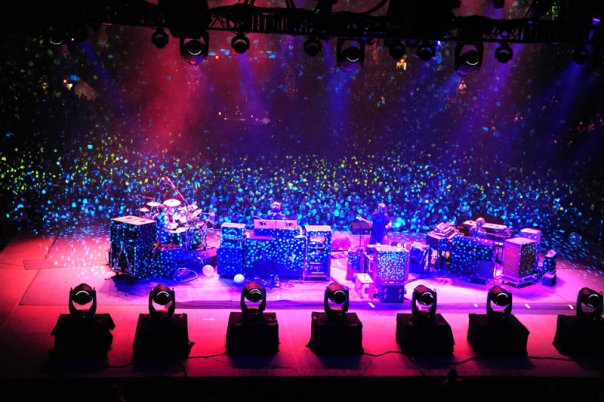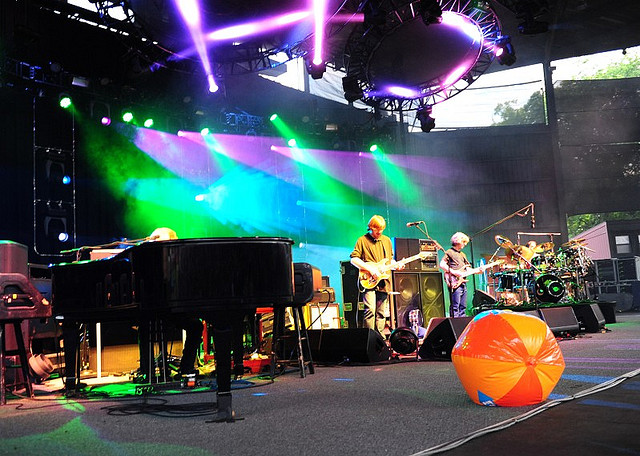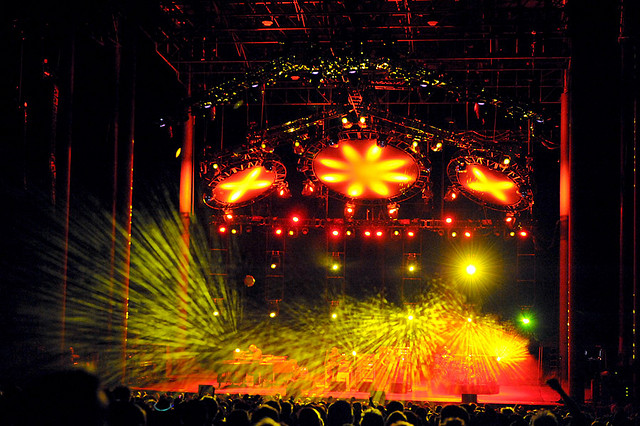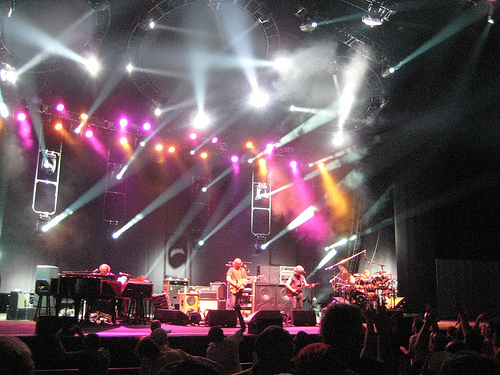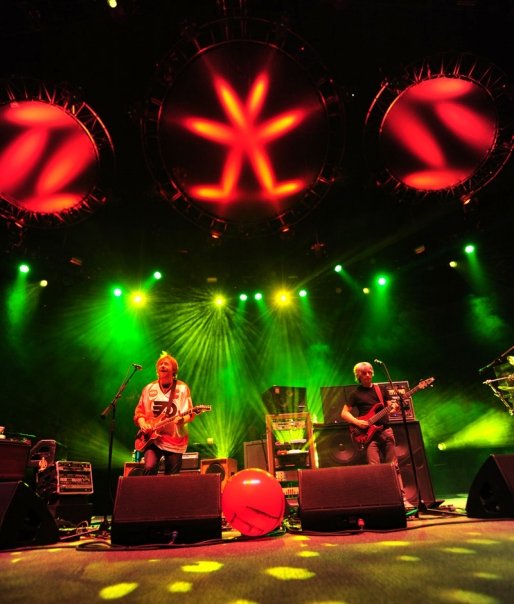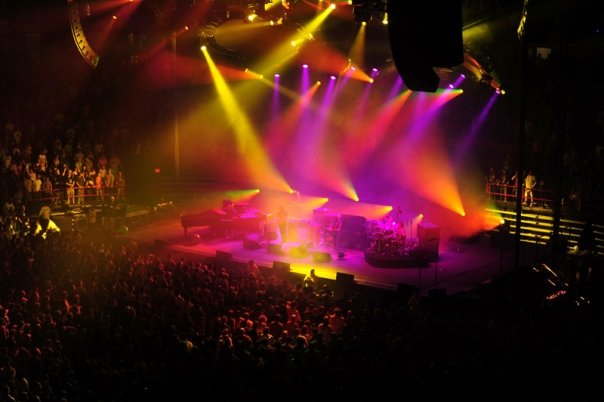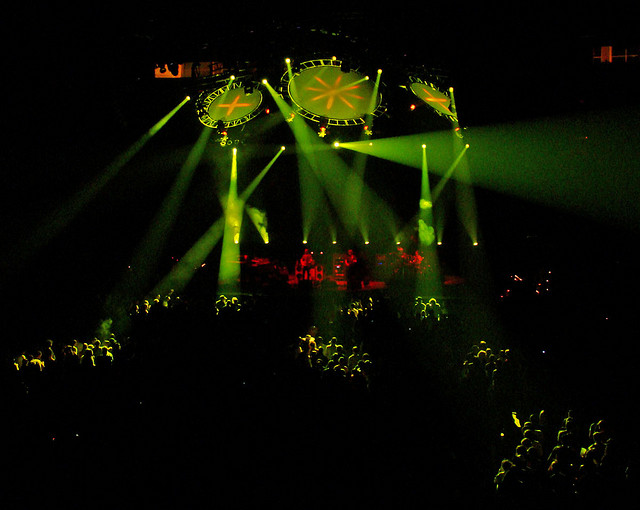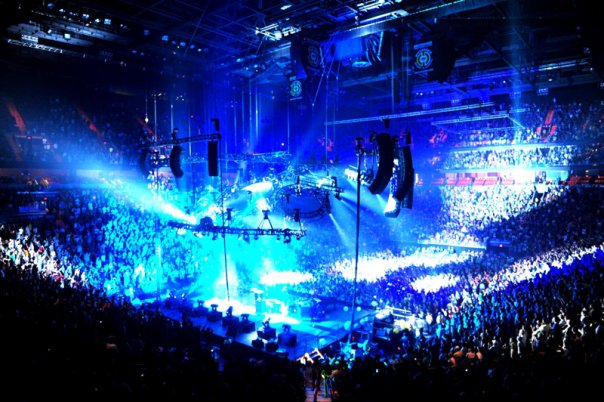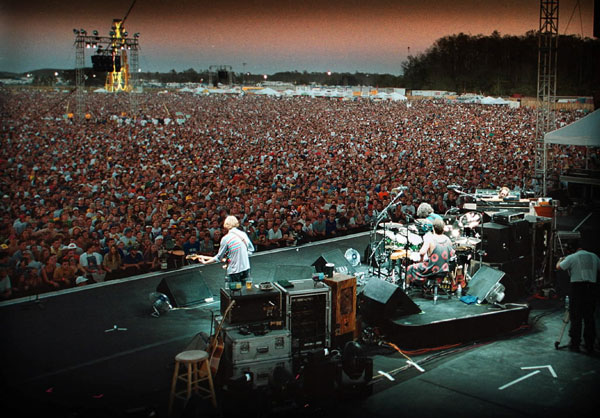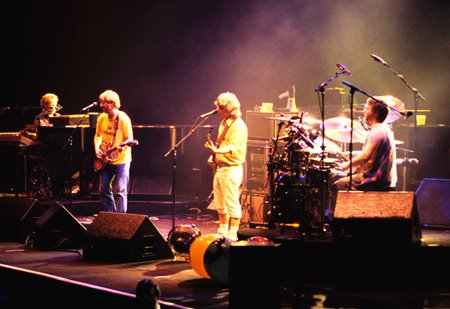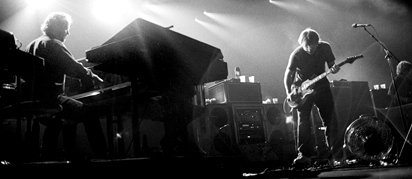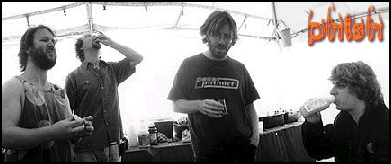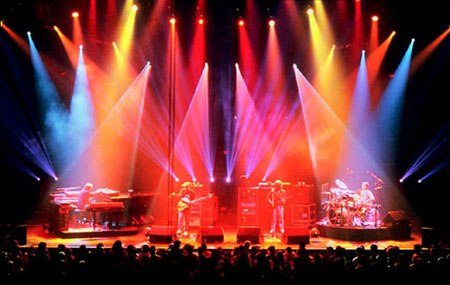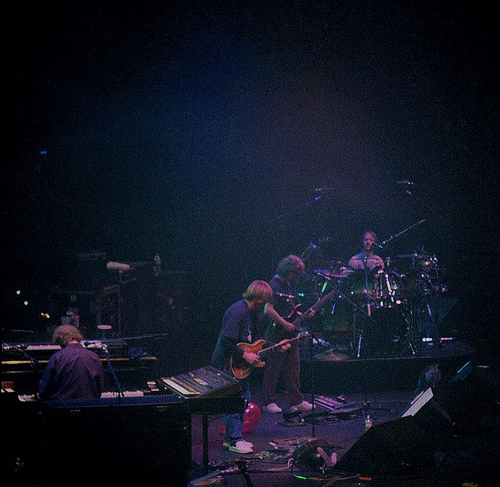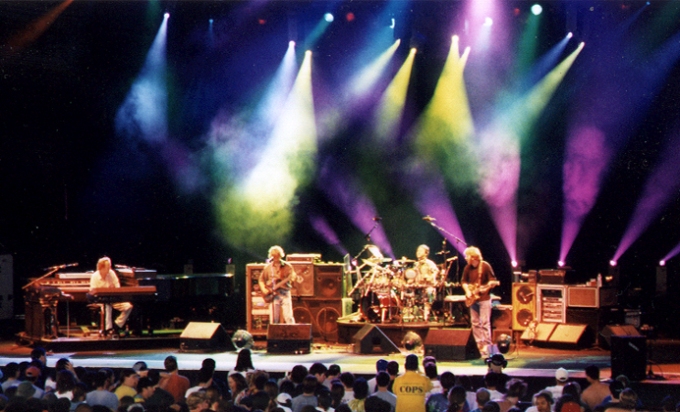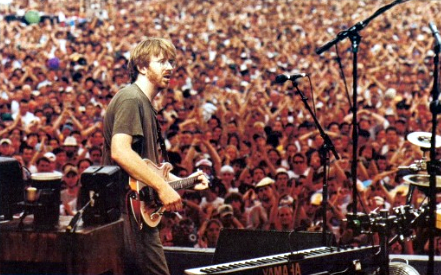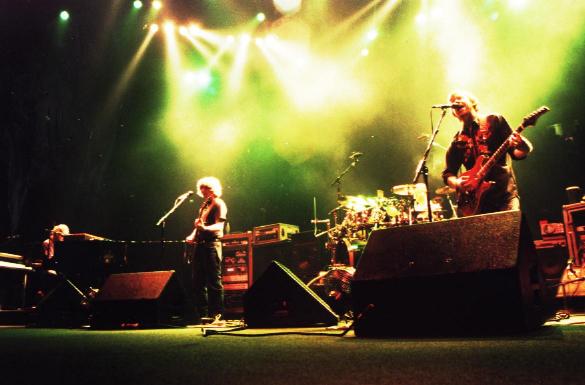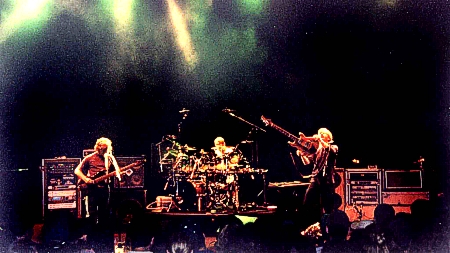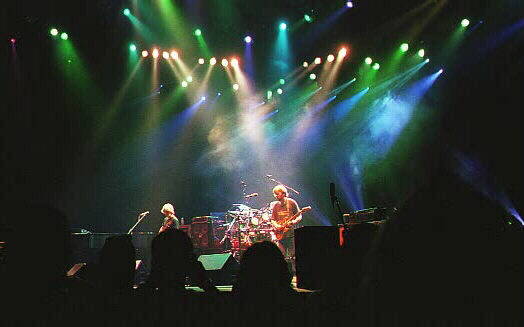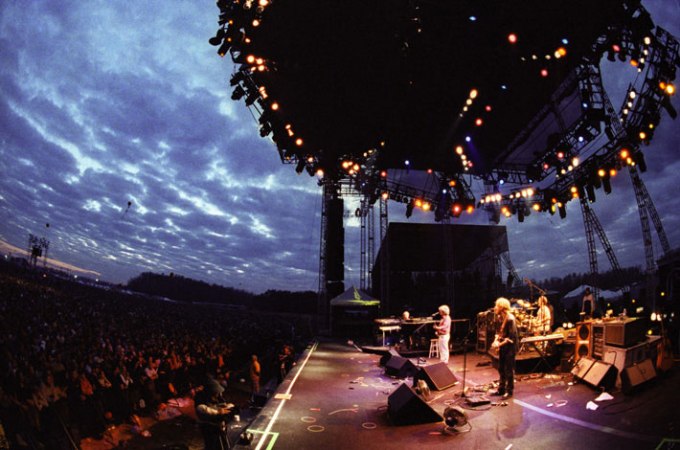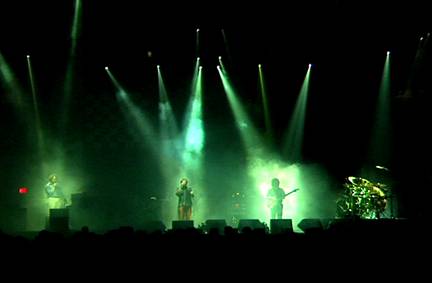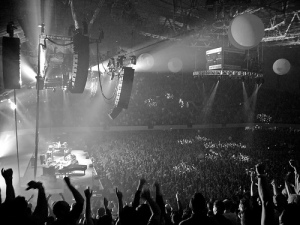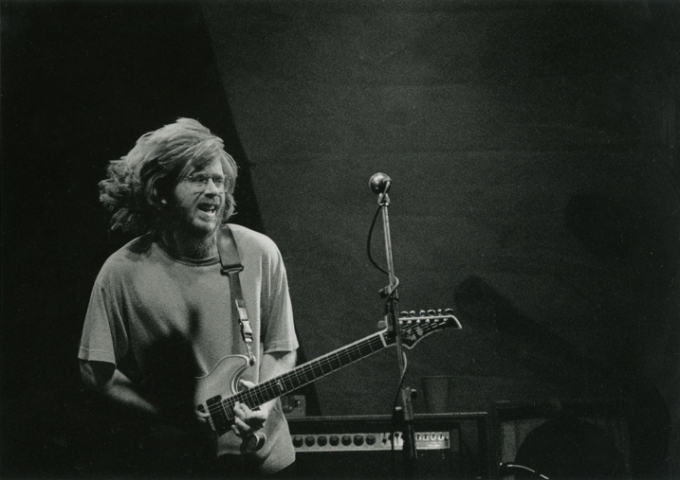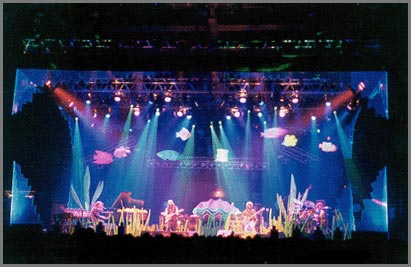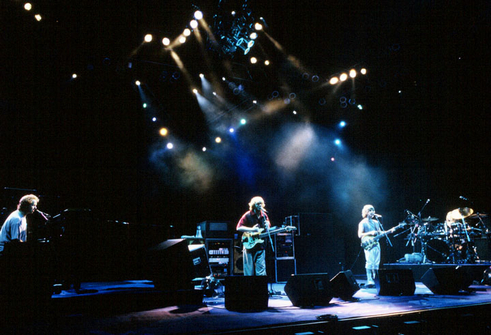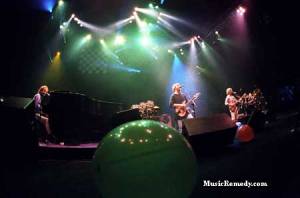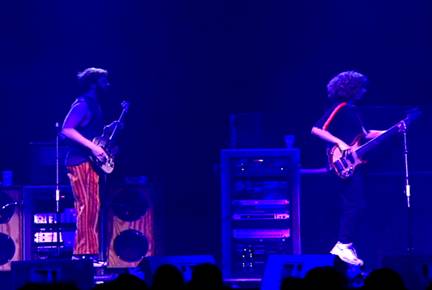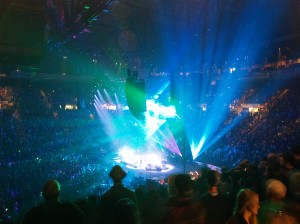
——– Back in 2010 I managed a blog titled The Suffering Jukebox. While it was a general music blog first, I used the opportunity to push my thoughts on Phish through the medium. These next two posts are a look back at my writings on Phish in 2010 and 2011. Part revisionist/Part preview of the Best of 2012 post I have in the works. More than anything, they offer us a look back at how far Phish has come in 3.0 ——–
With their year-long reunion tour behind them, many within the Phish community looked towards 2010 as the year when Phish would once again reclaim the title of “Best Goddamn Band On The Planet” that they had earned throughout the 1990’s, yet strayed from for much of the past decade. With a serious, back-to-basics campaign throughout their entire reunion year, all signs pointed towards the band evolving in much the same way they did in the early 90’s. To listen to a Phish show from 2009, one could take away many similarities to their sound in 1991 and 1992. There were very few jams, shows were very song-based, and for the most part, they nailed each of their complex compositions. This kind of dedication towards playing their songs right was a far cry from the sloppy, yet heavily experimental Phish that fell apart with such lack of care in 2004. Yet while many could argue that the playing was tamer and less adventurous than the band had been from 1994-2004, those with a keen ear towards their past knew that there would have been no heavy experimentation from the band without the years of tight, jam-less shows, where the band focused on chemistry, and hitting all their changes, rather than exploring the ethos.
Thus when the band concluded 2009 with an energized, fully-flowing, and yes, experimentally-heavy four-show New Year’s run in Miami, many saw this as a microcosm of the band’s evolution in the 1990’s. Many expected 2010 to kick off with a bang, as the band – a year of getting comfortable with each other on stage, and with playing their material, under their belt – could now relax and combine energized, sharp-playing, with the improvisational creativity that harkened back to their glory days of the mid-90’s.
And yet, as can be with art, not everything went as planned. While Phish opened 2010 with arguably their best tour opener since 1999, their string of shows throughout June hit multiple speed-bumps due in large part to Trey’s inability to relax on stage and let a jam build organically. Along with this was his overwhelming reliance on the Whammy Pedal – known affectionally throughout the community as the “Whale Call” – an effect which shifted pitches on his guitar creating more soundscapes rather than melodic guitar lines. While definitely a choice effect for ambient/noise-laced jams, many fans took issue when seemingly every composed piece, and every jam – no matter the style or direction – was suddenly bombarded by the whale. By the time the tour closed with a gimmicky 4th of July show, many were openly questioning the band’s direction, and why they seemed to be so lost after a year of such promise.
Returning to the stage in early August, for an eleven-show run that crossed the country, hitting only five-venues, many were skeptical, beginning to expect Phish to underwhelm them, rather than blow them away like they had so many times before. Yet mid-way through the first set of the band’s second show of the tour, everything clicked. Maybe it was the confined, archaic Greek Theatre, maybe it was the cool Bay Area air wafting up to the stage, maybe it was the spirit of the Grateful Dead, maybe it was the new guitar Trey was playing – one that held a deeper tone, thus making pitch-shifting less of an ideal effect, thus forcing him to play lead guitar once again – maybe they had just been together long enough once again, and everything finally fell into place. Whatever it was, when the band launched into their cover of the Talking Heads’ classic, “Cities,” they settled back into a groove that built through eleven funky minutes, culminating with a pristine segue into “The Moma Dance.” Listening to a live stream of the show, one could literally hear Trey sit back and let Mike and Fish build on a theme, while he and Page offered staccatoed licks over the gooey foundation. Realizing what they were witnessing, the crowd let off an astounding roar, pushing the band further into the unknown. What had once been commonplace within a Phish show was realized once again, as the band seemed to reawaken once again to everything that could happen on stage if they just allowed the music to carry them.
The entire paradigm of Phish 3.0 changed in those eleven minutes. Late in the second set, the band took “Simple” on a fifteen minute ride that touched on melodic ambient themes, moving through multiple segments before segueing into “Backwards Down The Number Line.” The next night the band topped themselves with an energized, classically flowing show that featured what many considered to be the jam of the year in “Light.” For the remainder of the tour the band re-discovered their improvisational spirit, crafting memorable jams out of “Carini,” “Down With Disease,” “Prince Caspian,” “Drowned,” “Backwards Down The Number Line,” and more. Combining their renewed spirit for simply playing their songs with the adventurousness that defined their latter years, many began to openly pronounce that we were on the verge of witnessing the greatest incarnation of Phish there was.
Building off of this energy, Phish played a fourteen-date Fall Tour in October that not only confirmed the renewed innovation in their playing, but in many ways, far surpassed anything they had done in all of 3.0. Returning to many smaller arenas they hadn’t played since 1994 & 1995, there was a noticeably youthful flair that dominated many shows on the Fall tour resulting in a combination of energy, gimmickry and improvisation, thus putting the stumbling blocks of 2009 and early 2010 far in the band’s rear view mirror. Be it their perfectly flowing, pristine setlist from the second night in Charleston, or their playful sets, full of rarities and back-and-forth segues in Augusta, Utica, Manchester, and the second night of Atlantic City, or their all-around solid shows – that year ago would have been duds – from the third night in Broomfield,, Providence, or the first night in Amherst, no longer did it matter what Phish played, for how they played seemingly always came through. Full of surprises, energy and power, the Fall Tour reminded every Phish fan why this band had captured them so many years ago. Topped off with a top-notch Halloween cover of Little Feat’s Waiting For Columbus, an album that perfectly matched the band’s current style, Fall Tour ended with Phish fans more excited for the future of Phish than any time since 1998.
Closing the year off with an unprecedented five-night New Years run in Worcester, MA and New York City, the band condensed the energy and excitement of the monumental year, into five shows, each with stand-out performances. While the Worcester shows offered a more mellowed affair, mixing rarities with more emotive jams, by the time they stepped on stage at Madison Square Garden on 30 December, the band was fully-oiled, and ready to explode. Throwing down memorable jams in “Tweezer,” “Ghost,” “Walk Away,” “Sand,” “Walls Of The Cave,” and “Simple,” the band sounded far more mature and capable than they had just one year earlier when they had taken their talents to South Beach. And fusing their past and present through one of their best New Years gags in years – bringing the 1994 hot dog out of retirement to ride around the Garden, while a chorus of international dancers sang the “Meatstick” – the band reminded anyone still wondering, that they were still the same goofy pranksters from Burlington, now just a few years older. Playing one of the best shows of the last year on their first ever New Years Day performance, the band sent a message that 2010 was not a definitive culmination, but was once again part of a climaxing process that will lead to yet another peak in their career. Who knows exactly what 2011 will bring for Phish, but one thing is certain: the band has regained their energy and is fully comfortable on stage again, and can annihilate full arenas through their music in the same way they did fifteen years ago. However one plans on seeing shows in 2011, be it on tour, or on couch tour, look forward to what’s certain to be an excellent year from The Phish From Vermont.
Below is a list of my Top 10 Jams and Top 10 Shows of 2010. Each list contains three honorable mentions. These are not simply shows/jams 11-13, rather they are shows/jams that were excellent in their own right, and helped to build the foundation of Phish in 2010, yet didn’t crack my final ten. Each list is organized chronologically to ensure flow from the start of 2010 to the end. There is no ranking, these are simply the best ten shows/jams of the year. Below each show is a download link, and there is a link after the entire list of jams.
Hope everyone enjoys these shows and jams! Happy New Year!
The Best Of Phish 2010
Honorable Jams

“Cities” – Berkeley, CA – 08/06/2010
The much-needed kick in the ass to Phish 2010 came five songs into the band’s second show at the intimate Greek Theatre, via their longtime cover of the Talking Head’s “Cities.” A song that had once been a guaranteed trip into the netherworld, “Cities” had been demoted to first set filler throughout much of 3.0, always certain to ignite a crowd through it’s infectious grooves, yet constantly leaving much to be desired. All of this changed in Bay Area this past August when Trey – known to rush the end of every jam – sat back on a thumping groove from Mike, and let the jam build organically. What ensued after the composed section of the song was a four minute clinic in groove, fooling anyone listening that it was the summer of 1998 rather than 2010. While there were more exploratory and innovative jams from the band in 2010, without the “Greek Cities,” one has to wonder the direction the band would have gone in for the remainder of the year.

“Reba” – Augusta, ME – 10/19/2010
Played as an encore for the first time in eleven years, Phish dropped this normally first set composition after playing one of their most inspired sets of the young Fall tour. While “Reba” had improved considerably throughout the summer, resulting in some of the most inspiring Type-I jams of the era, the “Augusta Reba” was a whole different beast all to it’s own. Departing completely from the structure of the rising solo, Trey directed the band into a darker realm, resulting in yet another tease of the elusive “Manteca.” Extending the jam through five minutes of unknown territory, the performance sent out a bold message that the antics of the second set, and the accomplishments made thus far throughout the tour were not all for naught, and that the band was keenly away of their inspired playing. Representative of the “anything goes” spirit of Fall Tour, the “Augusta Reba” shocked the hell out of everyone when it was first played and has had lasting power over many jams from the rest of the year.

“Seven Below -> What’s The Use?” – Worcester, MA – 12/27/2010
The first significant piece of improv on the New Year’s run came in the form of the weather-apt “Seven Below,” and it’s smoothly executed segue into the ambient “What’s The Use?” A song everyone knew was coming as a result of the horrid travel conditions for most fans heading to Worcester, when “Seven Below” dropped midway through the first set of the run, many anticipated a huge musical moment coming. Moving through a percussive section that still retained elements of ambient themes, the jam in “Seven Below” matched both the song’s title and weather in it’s icy feel. As it became more melodic, Trey began teasing the theme of “What’s The Use?,” ultimately segueing into it some nine minutes later. Always a welcome treat since it’s bust-out a year before in Miami, “What’s The Use?” finds itself on this list twice, both times perfectly matching the jam it emerged from and the mood of the set it was placed in.
The Top Ten Jams Of 2010

“Tweezer” – Hartford, CT – 06/18/2010
Midway through the second set of the first complete show of 2010 came the “Tweezer” everyone was waiting for. While much of 2009 had been reserved for a back-to-basics approach throughout their songs, anytime the band played “Tweezer,” everyone knew a powerful and inspired jam would emerge. Thus when they kick-started “Tweezer” in Hershey, PA, three nights into their summer tour, many expected a massive jam to be played. However, the version was more underwhelming than anything else, ultimately petering out into “Twist.” Less than a week later however, Phish played “Tweezer” again, this time giving it it’s proper 2010 due. Patiently entering the jam, Trey allowed Mike to build a solid and funky base, creating a dance-party throughout the Hartford Meadows. Yet the jam truly took off in it’s second section when Trey began offering more melodic leads, building the jam into a major-keyed, triumphant jam. Pushing the song to its extreme, Trey allowed the theme to wither away slowly, extending a contemplative ambient section far longer than he normally would. When it finally emerged in “Theme From The Bottom” some seventeen minutes after its inception, no one could utter a word.

“Chalk Dust Torture” – Camden, NJ – 06/25/2010
One of the rare Phish songs to serve as both an arena rock anthem and a free form improvisational excursion, “Chalk Dust” had seemingly been regulated to show opening rocker for 3.0. That is, until the second night of Camden this summer. Midway through an ultimately underwhelming tour, Phish was in search of inspiration in anyway they could find it. In effort to find a new, bold direction, the band opened the second set of the show with “Chalk Dust Torture,” a song that was normally played in the first set of shows. Immediately latching onto a searing minor theme once the song’s final chorus had been sung, Trey harnessed the powers of his Whammy Pedal, sculpting a wall of sound that allowed Mike, Fish and Page to build a groove-based jam. Yet the real hero of the jam was the bass-weilding mastery of Mike Gordon. As the jam began to lose direction fourteen minutes in, Gordo hit his envelope filter and unleashed a disco-infused theme that carried the song to yet another peak, before it dissolved. Once again proving his MVP-status throughout 3.0, Mike took this jam from simply a welcomed experiment, to one of the strongest musical moments of the entire year.

“Simple” – Berkeley, CA – 08/06/2010
While the “Cities” played in the first set of the second night at the Greek Theatre sent shockwaves throughout the Phish community, at the time no one knew if this was a one-and-done moment of inspiration or a theme that would carry throughout the remainder of the tour. After all, a year before, the fanbase witnessed as Phish took us on a fifty-minute excursion in Albany through “Seven Below -> Ghost,” only to see them reign in their improv considerably by the very next show. Yet as the composed section of “Simple” fell away, listeners could distinctly hear Mike and Trey hooking up through a looped melodic theme that Page and Fish quickly latched onto. Building on this playful theme for a few minutes, the band took the jam on a bubbling ride that peaked with choice and bright tremelo chords from Trey. Building through fifteen minutes of upbeat jamming, the song came to a proper conclusion as it spilled over into the appropriate “Backwards Down The Number Line.” While the “Cities” jam may have been the spark that lit the flame, the “Simple” reassured a fanbase desperate for creative playing from Phish.

“Light” – Berkeley, CA – 08/07/2010
Far and away, the song of the year, the version of “Light” at the Greek ranks up there with the best jams of 2010 and of the entirety of 3.0. Bursting out of the conclusion of “Wilson,” “Light” traversed through nine minutes of tension-and-release soloing from Trey before opening up into a vast ambient landscape that displayed an interplay and patience from the entire band, unseen prior in 3.0. Ditching his whammy pedal entirely, Trey latched onto the emotive theme established by Mike, offering choice licks around his swirling bass lines. Complimented by a renewed, rhythmically-charged Jon Fishman and beautiful fills from Page, the jam moved effortlessly through the unknown, reminiscent of the band’s playing from 1998-2000. In the midst of the band’s creative reawakening, the “Greek Light” is unsurpassed in terms of its role in pushing the band further into the unknown, while giving them direction and a foundation to build on for the remainder of the year.

“Down With Disease -> What’s The Use?” – Alpine Valley, WI – 08/14/2010
The centerpiece of one of the band’s best shows of 2010, the jam out of “Down With Disease” that effortlessly segued into “What’s The Use?” stands out as representation of the renewed exploratory spirit that overtook the band throughout August. After tearing through a blistering and precise solo, the band jumped on one percussive theme after another, resulting in a constantly unwinding, relentlessly exploratory jam that pushed further and further into the unknown through full-band interplay. Easily the most diverse jam the band has played in all of 2010, the song moved with such a frenetic pace that it’s hard to zero in on a single theme that reigns supreme. More than anything, the most impressive aspect of the jam, aside from the connectivity the band played with, was the fact that the segue into the airy “What’s The Use?” literally sounded composed. It is the most graceful segue the band has played in all of 3.0, one that came out of nowhere but fit perfectly as an extended fade after the relentless climb that was the seventeen minute “DWD.”

“Backwards Down The Number Line” – Wantagh, NY – 08/17/2010
Ever since it was used to kick off the first second set of Phish’s reunion show in Hampton, VA back on 06 March 2009, “Backwards Down The Number Line” has in many ways represented everything that is Phish in it’s 3.0 incarnation. A song of celebration and friendship, the song was originally a poem Tom Marshall wrote to Trey on his birthday in 2007, in attempt to reestablish contact with his recovering friend. Within five minutes Trey had given the song a melody, and in that moment the first hopes for Phish’s renewal were born. Yet for as emotionally uplifting as the song is, it has also become something of an enigma through its performances. At times an eight-minute Type I guitar solo, at others a fifteen-to-twenty minute excursion into the unknown, each time the song emerges, the entire crowd is left wondering what kind of “# Line” they’re about to hear. The version played on the first night of Jones Beach this past summer is without a doubt the song’s best, for the band combined the uplifting, melodic quality of the song’s theme, with an extended jam that lasted for fifteen glorious minutes. In the midst of one of their most unique, best flowing sets of the summer, “Backwards Down The Number Line” shone as the most inspired moment of the night, and one of the most enjoyable jams to re-listen to in 2010.

“Light” – Augusta, ME – 10/19/2010
My vote for jam of the year, and for the best jam of the entirety of 3.0, the “Light” played in Augusta, combined the exploratory spirit of Fall Tour with the highly energized, thematic jamming that was everywhere throughout their shows, in a jam that displayed connection and patience unlike any other. Moving rapidly through the song’s post-lyrical segment of tension and release, the band settled down by eight minutes in, into a melodic and bouncing theme that they would use to build their most connected jam of the year over the course of the next six minutes. Stripping away the fat, the band focused on Trey’s melodically staccatoed riff, building with him with the unison of a four-instrumented beast. Yet where in the past they would seek to build the theme quickly before quickly moving onto a new segment or song, the beauty of this “Light” is in the fact that the band took such noticeable pleasure in the theme, playing within it for five minutes of glory. Without a doubt the most inspired theme the band had stumbled upon to that point, the jam was a watershed moment in the tour, pushing them to continue searching for more hidden moments throughout the vast unknown of improv.

“Split Open & Melt -> Have Mercy -> Piper -> Split Open & Melt” – Utica, NY – 10/20/2010
While their show in Utica is generally renowned for the “Guyute,” “David Bowie -> Guyute -> David Bowie -> Wilson -> David Bowie -> Wilson -> David Bowie, Wilson -> Guyute -> Wilson” monstrosity in Set I, the true brilliance of the show came late in Set II through the “Split Open & Melt” sandwich that contained “Have Mercy,” and “Piper” within it. Since their comeback in 2009, no song has been as controversial as “Split Open & Melt.” A dark and seedy song by nature, the band has used it as their sole excursion to the disjointed and dark side, resulting in either terrifically nasty jams, or overall distorted, collapsing failures. Loved or hated, there has been no middle ground for “Split Open & Melt” in 3.0. So when it appeared late in the second set of the runaway show of the tour, there were those who rejoiced, and those who cringed at what was to come. By the end of the segment, literally all fans would be blown away by the musical craftsmanship displayed by the band throughout twenty torrid minutes. Dropping out of the rising theme almost immediately after the composed section finished, the band directed “SOAM” towards the abstract and ambient before Trey emerged with a gorgeous theme, soon recognized as the elusive cover of “Have Mercy.” Played for only the second time since 1999 – and the fourth since 1994 – the song was a welcome bright spot in the jam, with every fan noting it’s significance. Yet almost immediately after Trey stopped singing, he reverted back to the disjointed theme that typically dominates “SOAM,” signaling what many figured would be a segue back into the song. However, Trey had other ideas, stretched the jam out for seven minutes before cuing up fan-favorite “Piper.” A song whose jam has become increasingly nonexistent, Phish took this version on a powerful ride, teasing the jam of “Birds Of A Feather,” before locking into the theme of “Split Open & Melt” and directing the jam back to the origin of the excursion. While certainly no one would argue that the song was without some serious sloppiness, the greatness of it came in it’s harnessing of Phish’s playful spirit, and the twisted territory it explored. A jam that stands up to it’s gimmicky show, the “SOAM sandwich” was one of many moments from the Fall tour that sounds as good on speakers as it looked on paper.

“Tweezer” – New York City, NY – 12/30/2010
The Set II opener of the band’s first of three shows at Madison Square Garden, “Tweezer” was exactly what the show needed after a fun, albeit awkward first set. Building through two distinct segments, the jam was patient, it was incredibly exploratory, it was dark and seedy, and it was representative of everything the band had accomplished throughout 2010. After a funk jam led the song out of its gates, Trey brought the band back through a noise-laced ambient jam that didn’t fit the bill as your typical ambient fade into a new song. Instead, Trey allowed Mike and Page to build a theme over Fish’s percussive beats, emerging a few minutes later in a heated groove-based jam that harkened back to 2003. The last kind of jam anyone would have expected to come out of the greatest hits-type show the band played on New Year’s Eve Eve, the “Tweezer” blew everyone away, both those inside the Garden, and the thousands watching on the live streams from their couches. A possible new direction for the band in 2011, the “MSG Tweezer” more than anything displays that the band still is possible of conjuring up demons and playing as if locked in Hades, something many thought was far behind them.

“Ghost” – New York City, NY – 12/31/2010
Right smack in the middle of the best set of the New Year’s run came a jam that seemed to sum up the overjoyed emotion throughout the Phish scene, thanks to the band’s rejuvenated playing in 2010. After nailing the rhythmic break back into the song – something that took the band over a year to accomplish – Trey directed the jam out from it’s funky theme into a brighter and more melodic territory, one that would result in the most impressive and soaring jam Trey has led in all of 3.0. Locking in behind his spirt and theme, Mike, Fish and Page simply provided a base, allowing for Trey to display his regained chops in a solo that he would have simply been unable to play six months ago. Words really can’t describe this jam. It’s gorgeous in it’s building melody, in the peaks it bursts through, and then bursts through again. An explosion of energy from the band and all watching matched the jams peak, as everyone shared in the celebration of how far the band had come in a year, let alone since they reunited in March 2009. If there was any question how high of a regard the band held this jam immediately after it’s conclusion, it came in the set-closing performance of “You Enjoy Myself,” the seminal Phish song, and one most figured would be held off until the following set or the New Years’ Day closer.
Honorable Shows

Hershey Park Stadium – Hershey, PA – 06/13/2010
Set I: Gotta Jibboo, Chalk Dust Torture, Fluffhead, Funky Bitch, Runaway Jim>NICU>Horn, It’s Ice>Bouncing Around The Room>Sparkle, Split Open & Melt
Set II: Drowned>Tweezer -> Twist>Piper>Free, Wading In The Velvet Sea, You Enjoy Myself
Encore: Bold As Love
The final show of the first weekend of Phish 2010, everything came together at Hershey Park on a perfect summer day that was punctuated by an old-school show, and a flowing second set. Boasting a first set with no songs written after 1993, aside from the opener, Phish came out with a laid-back feel that matched the season and the half empty stadium. Gelling for the first entire show of the year, Hershey Park felt like the moment when the band finally adjusted to being on tour, settling back for the long haul. In the second set, Phish sought experimental groove-based jamming in “Drowned,” “Twist” and “Piper,” intermixed with rock in “Tweezer” and “Free,” and a late-set breather in “Wading In The Velvet Sea.” While at times disjointed because of Trey’s ADD-shifts from jam to new song, the show was the first complete show of the tour, topped off by a relentless, fire-breathing “You Enjoy Myself.”

Susquehanna Bank Center – Camden, NJ – 06/25/2010
Set I: Alumni Blues* -> Letter To Jimmy Page** -> Alumni Blues, Big Black Furry Creature From Mars, Runaway Jim, Army Of One, Free Man In Paris^, Summer Of ’89, Split Open & Melt, The Sloth, Time Turns Elastic, Golgi Apparatus
Set II: Chalk Dust Torture>Prince Caspian -> Heavy Things>Alaska -> 2001#>Light -> Possum>Character Zero
Encore: Shine A Light
* First “Alumni Blues” since 24 July 1999
** First “Letter To Jimmy Page” since 15 July 1994
^ Debut of “Free Man In Paris” – Joni Mitchell
# Multiple Michael Jackson-inspired teases throughout “2001” on the first anniversary of his death
A strong show that burst out of the gates with two bustouts in “Alumi -> Jimmy Page -> Alumni” and a rarity in “BBFCFM,” before easing into a more contemplative summer’s evening set, the second night of Camden was one of the few truly memorable shows from June mainly thanks to the powerful and flowing second set. Dominated by one of The Juke‘s jams of the year in Set II opener “Chalk Dust,” the show flowed through impressive playing by Trey in “Prince Caspian,” “Heavy Things” and “Alaska” before things turned experimental again with a segue into “2001.” A song that once meant a twenty minute journey to the outer realms of the galaxy, “2001” has been relegated to mere five minute late-set filler since 2003. However, on the one year anniversary of the death of the former King Of Pop, Phish turned the grooving jam into a journey through Wacko’s greatest hits. Teasing “Wanna Be Startin’ Something,” “Billy Jean,” and “Thriller,” the song had everyone at the show going crazy, while offering a classic and re-listenable dance party for all who weren’t in south Jersey for the show. The performance did wonders to rejuvenate “2001” for the remainder of the year, and each successive version was filled with an energy that had seemingly been lost. Segueing into a powerful and percussive take on “Light,” Phish used the performance as another opportunity to build the 3.0 anthem towards the glories it would realize later in the year. A dark-horse show in 2010, the second night at Camden saw Phish take far more risks than they did at most shows during the June run. The results would speak for themselves throughout the year.

The Greek Theatre – Berkeley, CA – 08/06/2010
Set I: Chalk Dust Torture, Guyute, Ocelot, It’s Ice, Cities -> The Moma Dance>Bathtub Gin, Stealing Time From The Faulty Plan
Set II: Rock & Roll> Ghost>Mike’s Song>Simple>Backwards Down The Number Line, Show Of Life, Seven Below -> Weekapaug Groove, You Enjoy Myself
Encore: Good Times Bad Times
Highlighted by the jams in “Cities” and “Simple,” which I discussed in the Top Jams segment, the second night at The Greek was the awakening the band needed in order to have the kind of revolutionary tour they had in August. With a strong setlist, and a fully flowing second set, powered by a diverse “Mike’s Groove,” the show never let up, showing a confident side of Phish many wondered if still existed throughout the inconsistent June run. To point out how killer this show was, consider the fact that the “Rock & Roll” jam would be a highlight at any other show, but here was the third best jam. After opening the August run with a solid, albeit safe show, Phish chose to make a statement on the second night of their three-night stay at The Greek. While night three would eventually surpass this night in terms of playing and song choice, for at least 24 hours, the second night reigned supreme as THE show of the year. I still get chills whenever I hear those jams, for this show was the breaking point between the first half of 3.0 and everything that has resulted since.
The Top Ten Shows Of 2010

The Comcast Theatre – Hartford, CT – 06/18/2010
Set I: Fee>Rift, Wolfman’s Brother, Summer Of ’89^, Foam, Possum>The Moma Dance>Julius, Reba, Cavern
Set II: Halley’s Comet>Light -> Billy Breathes, Tweezer -> Theme From The Bottom>Harry Hood -> Wading In The Velvet Sea, Stealing Time From The Faulty Plan
Encore: Sleeping Monkey+>Tweezer Reprise>Tweezer Reprise++
^ “Summer Of ’89” Made it’s Phish debut
+ Played for a fan who brought a sign requesting it the previous night
++ Played again to make up for the lack of “Reprise” at Hershey
A week into what was becoming an incredibly inconsistent tour, Phish threw down a perfect summertime show that carried an excellent setlist, patient, full-band jamming, and the kind of playful gimmickry that has long been associated with some of the best Phish shows. Opening with the old school combo of “Fee>Rift,” “Wolfman’s Brother,” the entire Meadows knew that the second night in Hartford would not only surpass the uneven first night, but would also go down as one of the shows of the tour. Playing an old school first set, akin to Hershey, the band followed a similar formula in Set II, by focusing on improvisation. However, where Hershey featured lots of improv within a somewhat uneven set, the second set at Hartford flowed like a river through jams, breathers and rock gems. Kicking things off with fan-favorite “Halley’s Comet,” the band took their first excursion in an ambient-laced “Light” that segued beautifully into the increasingly rare ballad, “Billy Breathes.” After the short stop, Trey kicked the set into full gear with a “Tweezer” that has stood the test of the entire year as one of the most powerful jams the band has played. The next highlight came in a beautiful “Harry Hood,” one that worked to build on the success of Blossom’s version, foreshadowing the great “Hoods” that would be seen later in the year. A quick burst of adrenaline in set closing “Stealing Time From The Faulty Plan,” ended the show on a high note, with everyone expecting a quick encore before making the drive to SPAC. However, in classic Phish fashion, the band used the encore to put their stamp on an epic show, playing fan-requested “Sleeping Monkey,” before diving into the “Tweezer Reprise Reprise.” Always an energetic and killer closer, Trey kicked the energy way up by announcing that they were going to play the song again in honor of not playing it in Hershey. The crowd lost it, Trey fed off the energy, jumped off his speakers, got on his knees, and sent everyone into the night absolutely crazed with excitement. The next night in SPAC, the band appropriately opened and closed the show with “Tweezer Reprise,” thus carrying the energy over and infusing the June run with the kind of excitement it so desperately needed.

Merriweather Post Pavilion – Columbia, MD – 06/27/2010
Set I: Walfredo*, Mellow Mood, Stealing Time From The Faulty Plan>The Divided Sky, Tela, My Soul, Ginseng Sullivan, Sample In A Jar> Bathtub Gin, Brian & Robert, Run Like An Antelope
Set II: Wilson>Meatstick& -> Saw It Again>Piper#>Ghost# -> Jumpin’ Jack Flash^ -> Saw It Again>Contact, You Enjoy Myself#
Encore: Fire#
* First “Walfredo” since 30 September 2000
& “Meatstick” contained Japanese lyrics
# “Piper,” “Ghost,” “You Enjoy Myself,” and “Fire” contained “Saw It Again” quotes
^ Debut of “Jumpin’ Jack Flash” – The Rolling Stones
Just when it appeared Leg one of Phish’s 2010 summer tour was going to be full of underwhelming shows, with a few solid ones dispersed throughout for good measure, Phish threw down an epic classic on their second night at Merriweather Post Pavilion. Opening with the rare, rotation song, “Walfredo” for the first time since 2000, followed by the just as rare, Bob Marley cover, “Mellow Mood,” sent a message that the show would be a keeper. With a first set full of solid performances of some of the fanbase’s favorite tunes, everyone was hunky dory as the band emerged for what would become one of the top sets of the year. Opening with “Wilson,” before moving into “Meatstick,” it appeared gimmickry was at work, and with the return of the Japanese lyrics to the song, everyone could tell Phish was having fun on stage. Moving into an ambient jam out of “Meatstick’s” theme, it appeared as though the band might take the song for an improvisational journey for the first time since 1999. However, a choppy segue into the rare, but always welcome, “Saw It Again,” threw that off, setting the table for a powerfully flowing second set that put the rest of the tour to shame. Out of the end of “Saw It Again” came a torrid “Piper” that built on percussive themes over sixteen blazing minutes, reminding many of the epic jam that emerged from the song in the same venue twelve years prior. Segueing into “Ghost,” the band road the song’s theme for ten minutes before moving effortlessly into the one-time cover of The Stones’ “Jumpin’ Jack Flash.” A song that had been teased many times in “Ghost” jams through the years, it was a fitting cover, coming some nine months after the band played Exile On Main Street in full the previous Halloween. Clearly overtaken by the energy of their surprise debut, the band built into a thrilling jam that moved back into the climactic peak of “Saw It Again,” before landing in the fan favorite classic, “Contact.” Closing the set out properly with a “Saw It Again” – infused “You Enjoy Myself,” the show ended on a high note with the seminal song toying with the thematic gimmick of the show. When they encored with “Fire,” a song reserved for shows worthy of it’s name, it was all but a given that this would go down as The Show Of The First Leg.

The Greek Theatre – Berkeley, CA – 08/07/2010
Set I: AC/DC Bag>Foam, Gotta Jibboo, Reba, Sleep Again, Army Of One, Poor Heart>46 Days>Tube, Character Zero
Set II: Wilson>Light -> Twenty Years Later>Harry Hood -> Theme From The Bottom, 2001>Suzy Greenberg>Slave To The Traffic Light
Encore: The Lizards, First Tube
Building on the experimental successes of the second night at The Greek, Phish came out firing on all cylinders on 07 August 2010, playing what many believe was the jam, and set of the entire year. Exactly a year after playing one of their best shows of 2009, the band played a balanced affair, featuring a flowing, energized and emotive first set and a greatest hits, patient second set that flowed perfectly from note one through its conclusion. The peak of the second set came in five specific places – the nine minute ambient jam that emerged out of “Light,” and was documented earlier in The Top Ten Jams of 2010, the beautiful build within the “Harry Hood” jam that featured some of Trey’s most inspired playing of the year, the bouncing, groove-heavy “2001” that echoed the Michael Jackson-themed version from Camden earlier in the summer, the jam in “Suzy Greenberg” that built out of the frenetic energy of the set and extended the song through ten dance-heavy minutes, harkening back to the powerful “Suzy” jams from the early part of the decade, and the set-closing “Slave To The Traffic Light” that saw Trey use the emotive playing in “Harry Hood” to create a gorgeous peak in the classic Phish number. The kind of show that would be a classic in any era, night three at The Greek immediately reestablished the line between a good show and an epic show in Phish 3.0

Alpine Valley Music Theatre – East Troy, WI – 08/14/2010
Set I: Tube>The Oh Kee Pa Ceremony>Suzy Greenberg, Funky Bitch>Reba, Fuck Your Face, Alaska, Back On The Train>Taste>When The Circus Comes, Lawn Boy, Sparkle, Gumbo>Run Like An Antelope
Set II: The Sloth, Down With Disease -> What’s The Use?>Scent Of A Mule, Mike’s Song>Dirt>Sneakin’ Sally Thru The Alley> Weekapaug Groove, Bug
Encore: Quinn The Eskimo
By the time Phish reached the midwestern Mecca of Alpine Valley in mid-August, they were a well-oiled-machine, one ready to blow the lid off the 40,000-person strong hillside amphitheater. Tearing out of the gates with a six-song opening segment that featured rarities – “Tube,” “Fuck Your Face” – the idyllic summertime composition – “Reba” – and high octane classics – “Suzy Greenberg,” “Funky Bitch” – by the time the band finally stepped back to figure out their next song to play, a good forty minutes had already passed by and the crowd was completely enthralled. It was really no wonder that the band basically had to be forced into setbreak after a fourteen song, nearly two hour first set. Yet, for as rocking as the first set was, it was the second set of the first night at Alpine that solidified the show as one of the peak performances of 2010. Opening with the rare, “The Sloth,” sent a wave of darkness spiraling through the venue, topped only when Mike began sending out the distorted waves that introduce “Down With Disease.” A song that has appeared in every Phish weekend at Alpine since 2003, there was really no question that the song would turn in the jam of the night. As described in the Top Ten Jams Of 2010 segment, the jam featured all four members working like a single unit, pushing the jam further and further into the ethos before finally caving into the heady bliss of “What’s The Use?” Taking a breather with “Scent Of A Mule,” Trey showed off his much improved chops, destroying the Mule dule, resulting in a resounding applause throughout the venue. At this point in the show, the band could have really done anything, and few would have groaned had they signaled the start of a ballad, yet when they dropped “Mike’s Song,” the place erupted, and Phish responded with one of the most inspired “Mike’s Song’s” in years. Filling the “Groove” with the contemplative “Dirt,” and a funk-throwdown in “Sneakin’ Sally,” the band capped it off with a fast-paced, collective jam in “Weekapaug Groove,” before closing the set with an epic and soaring guitar solo out of “Bug.” Choosing the Dead’s favorite cover, “Quinn The Eskimo” – a song that had been busted out after eleven years in Telluride, CO just a week prior – to encore at their favorite venue was a warm message to the fans that the show was a special one for everyone involved. Small wonder they decided to release it DVD just four months later.

Jones Beach Theatre – Wantagh, NY – 08/17/2010
Set I: Fluffhead, Kill Devil Falls>Cities, Funky Bitch>Wilson, Reba, Walk Away, Wolfman’s Brother>Possum
Set II: Lengthwise -> Maze, Halley’s Comet>Mike’s Song>Simple>Backwards Down The Number Line>Prince Caspian>Rock & Roll -> Weekapaug Groove, Loving Cup
Encore: Show Of Life, Golgi Apparatus
On the second to last show of Phish’s triumphant August run, the band threw down a fully flowing show, highlighted by great song selection and excellent jamming throughout. Along the same lines as night three at The Greek and night one at Alpine, Phish clicked from the moment they walked on stage, never once letting up. Choosing to open the show with “Fluffhead” for the first time since it reintroduced the fanbase to Phish in back in March 2009, the band sent a wave of energy through the venue, symbolically stating they understood the significance of their vastly improved playing throughout the run. Tearing through a high-energy first set, the band hit peaks in a thick “Cities” jam, a soaring late-set “Reba,” and a funky, bubbling “Wolfman’s Brother.” When they emerged for the second set, Phish seamlessly blended humor – “Lengthwise -> Maze” with a jam-packed “Mike’s Groove” centered around one of the best jams of the year in “Backwards Down The Number Line.” Throwing a curveball with a late set “Rock & Roll” – a song normally reserved for the Set II opener slot – the band locked into the theme of the song, building a powerful jam out of it, before segueing right into “Weekapaug Groove.” A show that put on high display the accomplishments of August, while still building towards the eventual peak of the year in the Fall, Jones Beach night one was one more memorable outing for Phish in the inspiring month of August.

North Charleston Coliseum – Charleston, SC – 10/16/2010
Set I: Kill Devil Falls>Guelah Papyrus, The Curtain With>The Mango Song>Sand, Limb By Limb, Sneakin’ Sally Thru The Alley, Uncle Pen, Pebbles & Marbles, Cavern -> David Bowie
Set II: Crosseyed & Painless>Dirt>Fluffhead>2001>Tweezer>Show Of Life, You Enjoy Myself
Encore: I Been Around, Quinn The Eskimo>Tweezer Reprise
After playing four shows on their Fall Tour, it was clear something was missing. No question the shows were solid, but the magic the band had conjured up through innovative and creative improv in August was nowhere to be found throughout the Colorado stand and the first night in Charleston. All this changed on a Saturday night in South Carolina, and when the band left the stage that night, they were a completely changed organism, never once looking back as they absolutely demolished the remainder of the tour. Kicking things off with the new school/old school combo of “Kill Devil Falls> Guelah Papyrus,” the band came out with an energy and tightness that had yet to be seen thus far. By the time they had reached the ethereal jam of “The Curtain With” it was clear the show was going to be a memorable one, one that would shape the remainder of the tour. Throwing out a mid-set surprise in the form of “Sand,” the show carried the “anything goes” vibe that normally accompanies tour highlights. Building an atypical jam, Trey backed away from his seedy licks, allowing the jam to be led by Mike and Page, forming a more melodically infused jam where normally a tripped-out electro-jam would unwind. Filling out the first set with well-placed rarities in “Sneakin’ Sally,” “Pebbles & Marbles,” and “Uncle Pen,” the band closed things out with a nasty combo of “Cavern -> David Bowie,” the later which built on the fantastic version in Colorado, blisteringly closing the set out like it used do on a regular basis. The second set however was on a completely different level. Flowing from note one, Phish blew the lid off the Coliseum with a raging cover of “Crosseyed & Painless,” before settling into a classic run of “Fluffhead>2001>Tweezer.” The latter two songs provided the musical highlight of the evening as the entire band engaged in minimalist playing, toying with varying themes and building single-minded jams that fused both the creativity of the August run, with the energy developing in the Fall. Closing the set with the appropriate, first “You Enjoy Myself” of the tour, Phish left the stage a more confident band than they had been when they first took it, playing what is still regarded as one of the best shows of the year. Encoring with the playful, reborn rarity, “Quinn The Eskimo,” only further emphasized the band’s renewed spirit. Fall Tour would never be the same.

Utica Memorial Auditorium – Utica, NY – 10/20/2010
Set I: My Soul, Stealing Time From The Faulty Plan, Vultures, Wolfman’s Brother# -> Cities>Guyute, David Bowie##, Wilson###>McGrupp & The Watchful Horsemasters>Saw It Again -> Run Like An Antelope
Set II: Drowned -> Sand -> Theme From The Bottom>Axilla I>Birds Of A Feather, Tela, Split Open & Melt -> Have Mercy -> Piper#### -> Split Open & Melt>Slave To The Traffic Light
Encore: Good Times Bad Times
# “Wolfman’s Brother” contained a “Streets Of Cairo” tease
## “David Bowie” contained multiple “Guyute” and “Wilson” teases
### “Wilson” contained a “Guyute” solo
#### “Piper” contained a “Birds Of A Feather” Jam
A night after playing a breakthrough set in Augusta, ME, one that fused gimmicks of lore – “Fuck Your Mike’s Groove” with the jam of the tour – and possibly the year – in “Light,” Phish came out with straight fire from the start crafting a humorous, fully-flowing, jam-packed show that has gone down as one of the heavily debated shows of the year. Boasting two complete sets, each with massive amounts of energy, musical prowess and gimmickry from the band, Phish harnessed the energy of a random Wednesday-night show in northern New York in the same way they had made a career out of for so long. Packing heat with a “My Soul,” “Stealing Time,” “Vultures” opening frame, the show got going in earnest with a funky stroll through the jam section of “Wolfman’s Brother,” which featured a distinct “Streets Of Cairo” tease from Trey before effortlessly melting into “Cities.” Answering the calls for the band to play “Guyute,” most notably from a masked man in the front row, the band tore through the composed tail of the ugly pig before getting down right dark and sinister in a fade into “David Bowie.” Looping the thematic solo from “Guyute” into the hazy “Bowie” hi-hat intro, Phish extended the intro like they hadn’t in years, creating a twisted, psychedelic wall of sound, before busting into the song proper. Pulsing with energy and excitement, Trey and Mike latched onto the similarities of “Bowie’s” breakdown to that of the intro of another classic, “Wilson.” Before anyone knew what was happening, the arena was chanting “Wilson,” in the middle of “Bowie,” giving all listening the trippy uncertainty of whether or not we were existing in 2010 or 1995. When they brought the jam back into “Bowie,” the band gave the song a fitting tribute, patiently building the theme before annihilating the peak. Fittingly, as soon as “Bowie” ended, Trey signaled the start of “Wilson,” carrying over the set’s theme, while stirring the crowd into a frenzy. Infusing the thematic solo of “Guyute” into the middle of “Wilson,” Trey brought to life the kind of distorted Phish humor that has long been missing from their shows. Fading into the old-school rarity, “McGrupp & The Watchful Horsemasters,” the band gave the nod of approval to the show, with a song that seems to only appear in the best shows. Yet for as entertaining as the middle segment of the set was, the final two numbers may have surpassed it all in terms of musical prowess and adventurousness. Playing “Saw It Again” for the first time since the famed Merriweather Post Pavilion show, the band extended the song’s demented ending into the ether before segueing into “Run Like An Antelope.” A song that had certainly lost some of its former fire in 3.0, Phish made sure to expand this “Antelope” to lengths and musical dimensions many had forgotten it could go. Reminiscent of the experimentation on “Reba” in the previous night’s encore, the “Antelope” that closed the first set was the reassuring sign that Phish was completely on top of their game, playing with an energy and spirit many had thought was a thing of the past. After playing such a powerful first set, the band could have very well thrown down a dud in Set II, and no one would have thought anything of it. However, while the second set doesn’t live up to the first set’s full on energy and musical precision, it was certainly a gem in its own right. Opening with the back-to-back jam combo of “Drowned -> Sand,” the band fused their collective jamming for close to twenty minutes before moving into more energized/rock territory with “Theme From The Bottom>Axilla I>Birds Of A Feather.” At a point when the band could have played the expected “Waste” or “Prince Caspian,” they opted for a breather in the old school “Tela,” a song that just breathes of youthful, idealistic Phish, and can only make one nostalgic for the amphitheaters of Summer Tour. After the break, the band kicked into one of the Top Ten Jams of the year in “Split Open & Melt -> Have Mercy -> Piper -> Split Open & Melt,” before closing things out with a beautiful, peaking “Slave To The Traffic Light.” A full show, front-to-back, Utica was the kind of special show that occurs once or twice a year, generally on a random night in a random town when no one is even considering a good show being thrown down. A powerful statement that reminded all that Phish certainly still has it, Utica 2010 will long live in Phish lore whenever people talk about “had to be there” moments.

Verizon Wireless Arena – Manchester, NH – 10/26/2010
Set I: After Midnight*, The Sloth, Alumni Blues -> Letter To Jimmy Page -> Alumni Blues, Mellow Mood, Access Me, Llama, All Of These Dreams, The Curtain With, Scent Of A Mule, A Song I Heard The Ocean Sing, It’s Ice>Walls Of The Cave
Set II: Possum>Light>Mike’s Song -> Simple> Makisupa Policeman -> Night Nurse^ -> Makisupa Policeman>The Wedge, Ghost -> The Mango Song>Weekapaug Groove# -> Llama
Encore: Show Of Life
* First “After Midnight” since 31 December 1999
^ Debut of “Night Nurse” – Gregory Isaacs
# “Weekapaug Groove” contained a “Can’t You Hear Me Knockin'” Jam and subsequent teases of “Ghost” and “Night Nurse”
For close to thirty years, Phish has made a career of playing their best at the most unexpected times, thus continuously staying under the radar while at the same time keeping their biggest fans constantly on their toes. Playing tour highlights in random towns in the middle of the week, or many times, just prior to a heavily anticipated show, Phish has long required that fans show up to each show, knowing full well that the one show you choose to skip could be the one people discuss for years. Thus when the setlist started rolling across the internet on a Tuesday night in late-October – Phish playing in tiny Manchester, NH, three nights away from their Halloween blowout in Atlantic City, NJ – it was fitting that their first set contained few songs played prior that tour. Opening with the Clapton cover, “After Midnight” for the first time since their all-night NYE Millennium blowout in Big Cypress, FL, everyone knew Manchester was going to be one of those shows. Tearing through rarities – “The Sloth,” “Alumni Blues -> Letter To Jimmy Page -> Alumni Blues,” “Mellow Mood,” “Llama,” “A Song I Heard The Ocean Sing” – while offering incredible musical adventurousness in a beautiful “The Curtain With” and a raging “Walls Of The Cave,” the first set was the kind that blew everyone away, and had all buzzing about what the second set might hold. Coming out on a mission, Phish opened with one of the fiercest “Possum’s” in recent memory before unleashing another stand-out “Light” in a tour full of them. Harnessing a percussive theme that was reminiscent of Augusta’s masterful version, while still venturing out into it’s own unique realm, the band crafted yet another improvisational memory for the tour. Opting to use the remainder of the set for another expansive “Mike’s Groove,” the band took an opportunity by way of the always welcome “Makisupa Policeman” to pay tribute to the recently deceased reggae legend, Gregory Isaacs. Segueing seamlessly into his classic “Night Nurse,” the band interwove a musical highlight with a telling sign of gratitude. The final musical highlight of the night came in the surprise late-set “Ghost” which built out of it’s seedy origins into a powerful, melodic jam that brought the bright and shiny “The Mango Song” out from hiding, before it too segued into “Weekapaug Groove.” A song that has been a constant gem since Phish’s 2009 return, the band took “Weekapaug” on a wild ride in Manchester, evolving it into a jam on “Don’t You Hear Me Knockin'” that featured teases of “Night Nurse” and “Ghost,” before speeding the jam up to an absurd pace, segueing it into a full-on reprise of “Llama.” Capping off a night of rarities, jams and all-out Phish-fun, Manchester was the last proper show of Fall Tour, and one that capped off an incredibly powerful three weeks on the road for the band. On to their three-night Halloween party in Atlantic City, Phish was cruising on the kind of peak they hadn’t been on in years. All was right in the world.

Boardwalk Hall – Atlantic City, NJ – 10/30/2010
Set I: Kill Devil Falls>Cavern>Foam, Guelah Papyrus>Chalk Dust Torture -> Whole Lotta Love* -> Chalk Dust Torture, Ha Ha Ha#>Walk Away, Wolfman’s Brother -> Undermind>Bathtub Gin, The Squirming Coil
Set II: Tube>Possum#&>Tweezer# -> Heartbreaker^ -> Tweezer -> Ramble On** -> What Is And What Should Never Be^>Tweezer -> Stairway To Heaven^$, Halley’s Comet -> 2001 -> David Bowie, Show Of Life>Backwards Down The Number Line>Good Times Bad Times
Encore: Sleeping Monkey>Tweezer Reprise#
* First “Whole Lotta Love” since 01 March 1991
** First “Ramble On” since 12 August 1998
# “Ha Ha Ha,” “Possum,” “Tweezer” and “Tweezer Reprise” all contained “Whole Lotta Love” quotes
^ Debut of “Heartbreaker,” “What Is And What Should Never Be” and “Stairway To Heaven” – Led Zeppelin
& “Possum” contained a “Sneakin’ Sally” tease
$ After “Stairway To Heaven” Trey say’s “Happy Halloween! See you all next year.”
The night before THE night. Similar to Phish’s reputation for throwing down huge shows in the middle of nowhere, they’ve also garnered the reputation of a band that will play the best show, the night before a holiday/highly anticipated show. From 12/30/1993 to 12/29/1995, 08/14/1996 to 12/30/1997, 12/01/2003 to 12/30/2009, time and time again, Phish will blow fans away with a massive show the night before they were supposed to. In keeping in line with their prankster past, this has become something of a game for fans, always left in the dark as to what nights will be THE show until it happens. When Phish took the stage on 10/30/2010, their second night of a three-night stand at Atlantic City’s Boardwalk Hall, the feeling of a big show resonated throughout the entire fanbase, and boy did the band come through. Tearing through an opening four-song segment of “Kill Devil Falls>Cavern>Foam, Guelah Papyrus,” the crowd rang with such approval, responding with a massive – not to mention unheard of – glowstick war in the middle of “Guelah.” Sensing their opportunity, with the crowd in the palm of their hand, Phish tore into a rocking mid-set “Chalk Dust Torture” that segued fluidly in-and-out of Led Zeppelin’s “Whole Lotta Love.” With little fanfare surrounding the upcoming Halloween cover album, fans had been left to their own imaginations leading up to Halloween, with many surmising that Led Zeppelin’s Physical Graffiti was the ideal choice for the band this year. A cover of “The Rover” that the band destroyed from June only seemed to further confirm this. Yet before the crowd or the fanbase could properly react, Phish launched into the rare, Fishman-penned “Ha Ha Ha,” all but promising there would be no Zeppelin the following night. The end of the set featured more stand-out performances of “Walk Away,” a nasty segue of “Wolfman’s Brother -> Undermind,” yet another soaring, Type I “Bathtub Gin,” and a contemplative “Squirming Coil” to send the crowd into setbreak musing over the Rock fest that just went down. Yet in perfect Phish fashion, the band took the successes of their first set and crafted a powerful monstrosity that only furthered their gag on the crowd, while continuing to redefine their relationship with their fanbase. Coming out swinging with a “Tube>Possum>Tweezer” opening segment, it was clear the band was on for another legendary set. However, as they moved out of the song structure of “Tweezer,” and into the jam, the band latched onto the theme of “Whole Lotta Love” yet again, a theme which would take them on a trek through some of Led Zeppelin’s biggest songs, all within the confines of “Tweezer.” In a fifteen minute rock & roll sandwich, the band played “Heartbreaker,” “Ramble On,” “What Is And What Should Never Be,” and “Stairway To Heaven,” all but disposing any hope that they’d play Physical Graffiti the next night, yet giving their fans something they’d always wanted. While clearly unrehearsed, somewhat sloppy, and more humorous than anything, the “Tweezeppelin” sandwich was yet another creative way for the band to not only toy with their audience, but also give them a performance many had been begging for for years. Even more, Phish was now one of the few rock bands to break the code by playing both “Freebird” and “Stairway,” yet the ways in which they’ve placed them in their shows – “Freebird” is always sung accapella – says tons about their creativity and playfulness. Finishing off the set with a spacey “2001” that segued into yet another blistering “David Bowie,” the show was capped off by the eternally classic encore: “Sleeping Monkey>Tweezer Reprise.” While there were far more impressive musical outings throughout 2010, 10/30/2010 was the kind of show that put on high display the humor of the band, and the playful spirit they continue to share with their fanbase.

Madison Square Garden – New York City, NY – 01/01/2011
Set I: My Soul, Tube>Runaway Jim>Foam, Guelah Papyrus>The Divided Sky, Round Room*>Walk Away>Gotta Jibboo, Reba, Walls Of The Cave
Set II: Crosseyed & Painless>Twist>Simple>Sneakin’ Sally Thru The Alley>Makisupa Policeman -> David Bowie
Encore: Fee, Frankenstein&
* First “Round Room” since 13 July 2003
& Page was on the Keytar for “Frankenstein”
While technically played in 2011, Phish’s first ever New Year’s Day show will always be viewed as a culmination of the 2010 sound. The fact that it was played on the first day of 2011 will only display forward continuity and progress when looked back at, midway through their summer tour. Featuring a killer setlist with literally no breather’s or throwaway songs, Phish came out to play on New Year’s Day, their fifth show in six days, and their last before an almost certain six month break in touring. Anyone wondering if this would shape up to be the dud of the tour was hushed when during the bluesy opener “My Soul,” Trey all but refused Page’s reentry to the song, opting to instead extend his powerful solo a minute longer. From there the band tore through classics – “Runaway Jim>Foam,” “The Divided Sky” – and rarities – “Tube,” “Guelah Papyrus,” “Round Room” – before closing the strong set off with blistering renditions of “Gotta Jibboo,” “Reba” – probably the best pure version of the year – and the revived 2.0 anthem, “Walls Of The Cave.” Fusing all the right elements for a classic show, Phish emerged from setbreak, ready to unleash yet another perfectly fluid second set, one that rivaled the mastery of 10/16/2010 and 08/07/2010. Opening with the “Crosseyed & Painless” – a song that until a year ago was generally a once a year affair, the song has somewhat slipped into the band’s rotation, producing strong and raging jams each time around – the band made it known right away that they were ready to tear the Garden a new one. Segueing into “Twist,” the band built on the rhythmic grooves that had dominated the year, crafting a dance-heavy jam that morphed into the arena rock of “Simple.” A song that offered us one of the top ten jams of 2010 back in August, this version, while not nearly as dynamic and expansive, grew effortlessly from the song’s theme into a bubbly and melodic jam that somehow led right into the chunky grooves of “Sneakin’ Sally.” Tossing the now-common vocal jam onto the end of the lyrical segment of the song, Phish used sparse and funky beats alongside a strutting rock melody to extend the jam before they found themselves in the cool reggae of “Makisupa Policeman.” A version reminiscent of the airy space of Champaign, IL’s 11/19/1997 version, Trey offered the comedy line of the night in: “Went back home last night after doing the New Year’s stunt / I laid back on my couch and rolled myself a blunt,” to great approval from the audience and Page. Clearly relaxed by this point in the show, Trey allowed the jam to be reduced to nothing before building a placid wall of ambient noise and sound. The musical highlight of the set and the show, the band rode the ambient wave perfectly into the hi-hat intro of “David Bowie,” capping off the set with one final blistering version for the calendar year. For the encore, the band celebrated the return of the megaphone to “Fee,” something that had been unveiled over the summer in Deer Creek for the first time since 1997, and used throughout the Fall. Tying in the playfulness of the year, the song was the perfect lead-in for the all-out arena rock of “Frankenstein” complete with Page on the keytar. A proper conclusion to such a massive year of growth, development, creativity and newness within the Phish community, 01/01/2011 bridged the gap between the year that was, and all that is to come for Phish in 2011. A fitting conclusion for the year, and this list. Can’t wait to see what 2011 brings for Phish!
——-
Thanks to Phish.Net (www.phish.net) and The Mockingbird Foundation (www.mbird.org) for organizational assistance and sourcing of setlists!
 Stepping to the stage in front of an eager and packed house, Phish opened with one of their storied, compositional masterpieces: David Bowie. A song known for its eerie kinetic energy as much as it is its open-ended spaciousness, it’s the kind of song that announces a BIG show simply in its presence alone. Containing only two lyrics: “David Bowie” & “UB40” – both shouted with youthful irreverence and a satirical nod towards their arena rock forbearers – the song is built upon the duality of its maddeningly spinning harmonic interplay, and ultimate release into the musical unknown.
Stepping to the stage in front of an eager and packed house, Phish opened with one of their storied, compositional masterpieces: David Bowie. A song known for its eerie kinetic energy as much as it is its open-ended spaciousness, it’s the kind of song that announces a BIG show simply in its presence alone. Containing only two lyrics: “David Bowie” & “UB40” – both shouted with youthful irreverence and a satirical nod towards their arena rock forbearers – the song is built upon the duality of its maddeningly spinning harmonic interplay, and ultimate release into the musical unknown.













